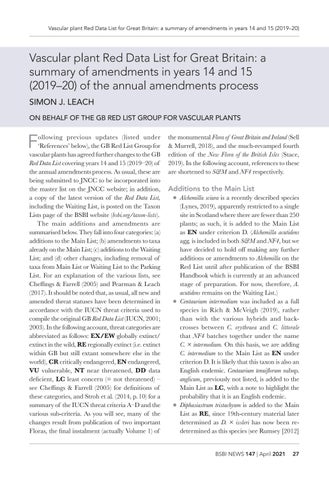Vascular plant Red Data List for Great Britain: a summary of amendments in years 14 and 15 (2019–20)
Vascular plant Red Data List for Great Britain: a summary of amendments in years 14 and 15 (2019–20) of the annual amendments process SIMON J. LEACH ON BEHALF OF THE GB RED LIST GROUP FOR VASCULAR PLANTS
F
ollowing previous updates (listed under ‘References’ below), the GB Red List Group for vascular plants has agreed further changes to the GB Red Data List covering years 14 and 15 (2019–20) of the annual amendments process. As usual, these are being submitted to JNCC to be incorporated into the master list on the JNCC website; in addition, a copy of the latest version of the Red Data List, including the Waiting List, is posted on the Taxon Lists page of the BSBI website (bsbi.org/taxon-lists). The main additions and amendments are summarised below. They fall into four categories: (a) additions to the Main List; (b) amendments to taxa already on the Main List; (c) additions to the Waiting List; and (d) other changes, including removal of taxa from Main List or Waiting List to the Parking List. For an explanation of the various lists, see Cheffings & Farrell (2005) and Pearman & Leach (2017). It should be noted that, as usual, all new and amended threat statuses have been determined in accordance with the IUCN threat criteria used to compile the original GB Red Data List (IUCN, 2001; 2003). In the following account, threat categories are abbreviated as follows: EX/EW globally extinct/ extinct in the wild, RE regionally extinct (i.e. extinct within GB but still extant somewhere else in the world), CR critically endangered, EN endangered, VU vulnerable, NT near threatened, DD data deficient, LC least concern (= not threatened) – see Cheffings & Farrell (2005) for definitions of these categories, and Stroh et al. (2014, p. 10) for a summary of the IUCN threat criteria A–D and the various sub-criteria. As you will see, many of the changes result from publication of two important Floras, the final instalment (actually Volume 1) of
the monumental Flora of Great Britain and Ireland (Sell & Murrell, 2018), and the much-revamped fourth edition of the New Flora of the British Isles (Stace, 2019). In the following account, references to these are shortened to S&M and NF4 respectively.
Additions to the Main List
• Alchemilla sciura is a recently described species
•
•
(Lynes, 2019), apparently restricted to a single site in Scotland where there are fewer than 250 plants; as such, it is added to the Main List as EN under criterion D. (Alchemilla acutidens agg. is included in both S&M and NF4, but we have decided to hold off making any further additions or amendments to Alchemilla on the Red List until after publication of the BSBI Handbook which is currently at an advanced stage of preparation. For now, therefore, A. acutidens remains on the Waiting List.) Centaurium intermedium was included as a full species in Rich & McVeigh (2019), rather than with the various hybrids and backcrosses between C. erythraea and C. littorale that NF4 batches together under the name C. × intermedium. On this basis, we are adding C. intermedium to the Main List as EN under criterion D. It is likely that this taxon is also an English endemic. Centaurium tenuiflorum subsp. anglicum, previously not listed, is added to the Main List as LC, with a note to highlight the probability that it is an English endemic. Diphasiastrum tristachyum is added to the Main List as RE, since 19th-century material later determined as D. × issleri has now been redetermined as this species (see Rumsey [2012] BSBI NEWS 147 | April 2021
27
















